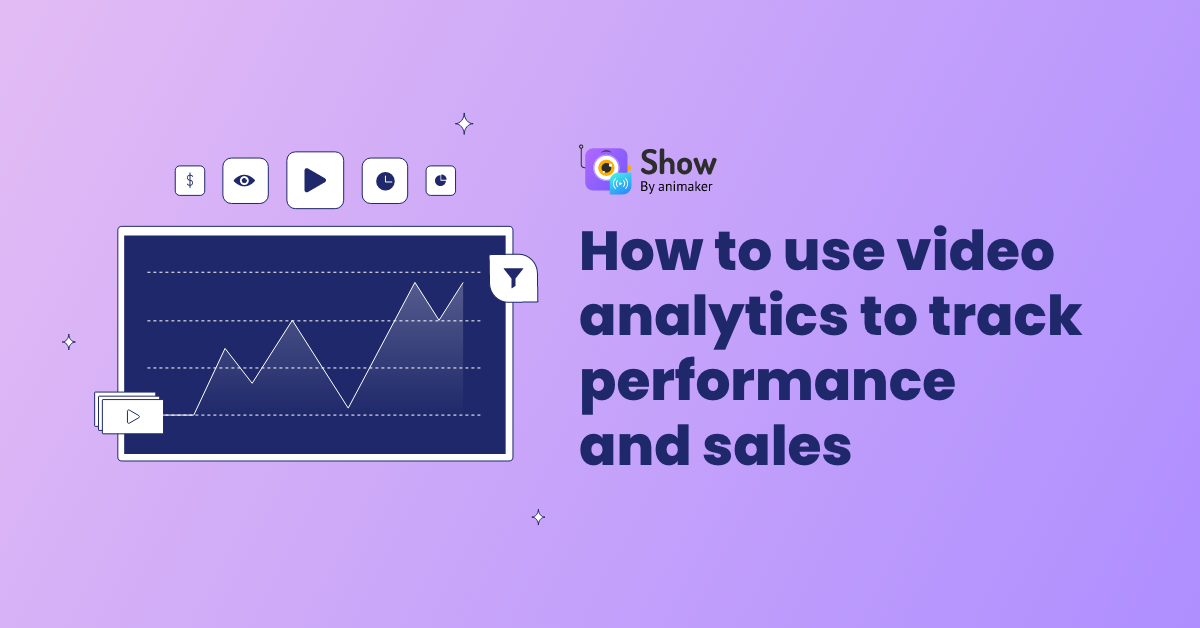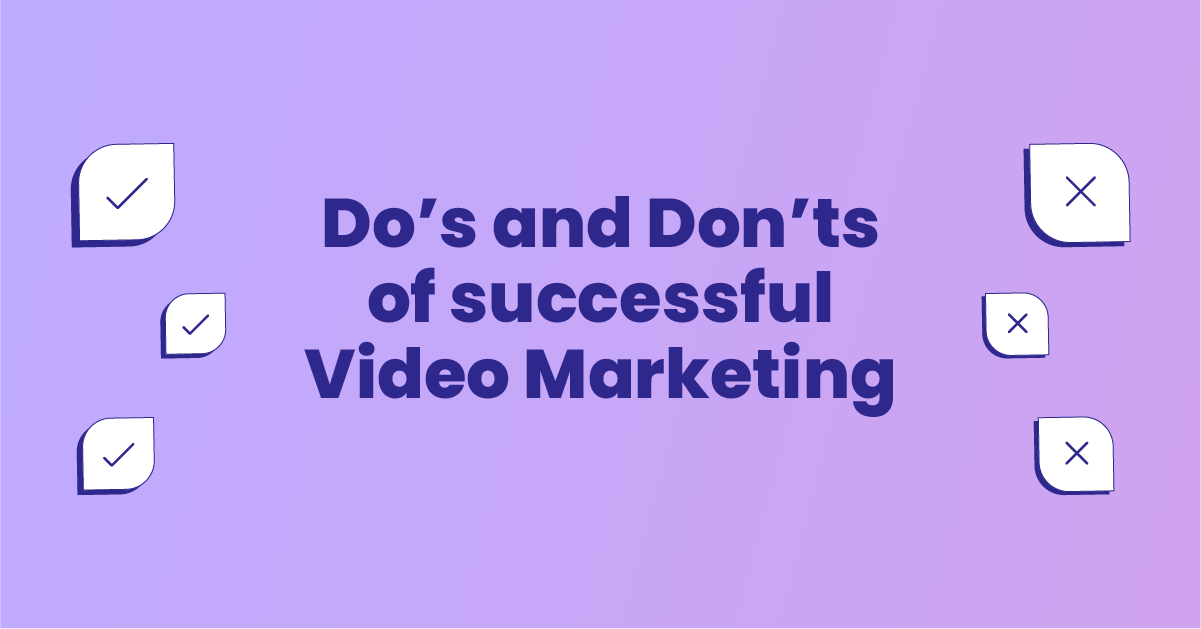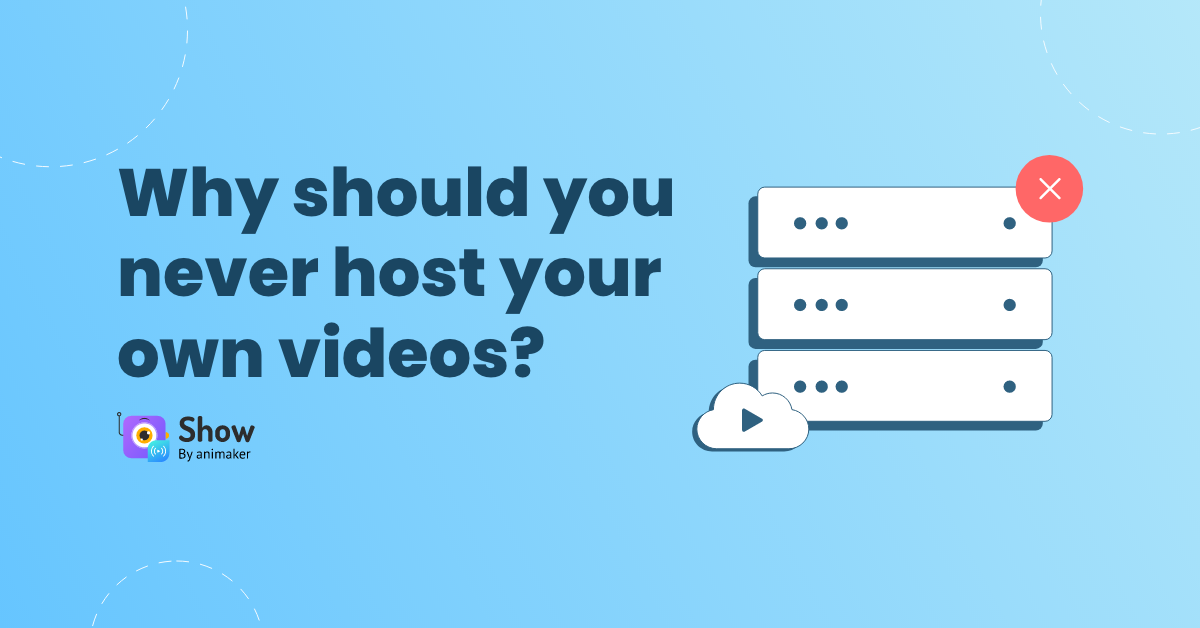Contents
How to use video analytics to track performance & Sales
Why do you need to use video analytics?
How does video analytics work?
The use case for marketing team:
The use case for the sales team:
Types of video analytics metrics:
How to optimize these video analytics metrics?
How to Use Video Analytics Metrics to Track Performance & ROI
How to use video analytics to track performance & Sales
“How many views did the last video get?”
This is a question that is often discussed in boardrooms where the marketers of the organization are asked. While this question is a fair one, the above metric alone doesn’t do justice to a video’s performance.
Your video may get a million views overnight, but if the viewers are not a part of your target market, then it is a complete failure. This is why you need to have a clear analytics strategy where you have an overall view of the video by measuring a variety of metrics. The video metrics that you measure should be relevant to your business goals. In this article, we will learn how to use video analytics to track performance, and how it can help sales and marketing teams.
What is video analytics?
Video analytics gives you an overview of how your viewers are enjoying your video and is of great help to sales and marketing professionals. Videos are one of the most popular marketing collaterals, and it is no wonder that it has grown in popularity over the past few years. It is predicted that by 2021, the average person will spend 100 minutes a day watching online videos.
Why do you need to use video analytics?
Not using video analytics to track how your videos are faring would be like having a superpower but not using it. Video analytics can change the way you do marketing. It can be the difference between a huge windfall to your bottom line and to a mediocre performance.
1. Use the data for your video marketing campaigns:
Lead scoring methods use a variety of engagement data to identify the ones that are most likely to turn into a customer. With the help of video engagement data, you can assign individual values to leads on automation.
2. Qualified leads won’t slip through the cracks:
The problem with using third-party platforms like YouTube or Facebook to host your videos is that they do not care whether you get users, instead, all they care is about keeping the viewer on their site for a long time. Also, there is no room for advanced analytics that tools like Show boast of. With advanced analytics, you know where and how the user is spending time on the video. It can be used to create additional content to keep these viewers engaged with your brand.
Image: Getstucked
3. Influences your customer experience initiatives:
Video engagement analytics plays a huge role in how you can influence your customer experience initiatives. By collecting data on a granular level, you will be able to align your video campaigns based on what your prospective customers are hoping to get from you. Since videos drive the most engagement, it makes sense to drive user engagement to the channel that offers the most. With the help of advanced data analytics, videos can even be used to trigger additional engagement.
4. Increase in traffic:
Thanks to the variety of data on your videos that you get from video analytics, you will be able to come up with strategies that increase the efficacy of your videos. By using the metrics that you are measuring, you will know which are the videos that deserve more attention, and the categories that require more content.
Image source: Tenor
How does video analytics work?
Video analytics tells marketers how engaging a video is for the users. With the help of a video CMS tool, you will be able to gather metrics of each video. You can track engagement rate, play rate, viewing time duration, and so on, for every single video. It will tell you which are the content categories that deserve more attention.
There would be no need to indulge in guesswork when you have a good video analytics engine that gives you highly actionable information. Using this information, you can understand what is working and what is not, and you will be in a great position to exceed the expectations of your audience.
While you will surely find analytics tools available inside the likes of YouTube, Facebook, Instagram, etc., none of them will be as powerful as the one that you will see in a good video CMS tool.
Use cases of video analytics:
Measuring the ROI of video content provides a lot of insights to both marketing and sales teams. Both teams can use the data from video analytics to their advantage to benefit themselves. If used in the right manner, video analytics can be the strongest weapon in the arsenal of your sales and marketing team. Let us look at how video analytics can be used by marketing and sales teams individually.
The use case for marketing team:
Through video analytics, marketing teams can unearth brilliant insights. From knowing which is the right video to show to marketers to the number of people who have either downloaded the video or watched or re-shared it, video analytics offers a treasure trove of data that can be used to make a lot of changes. Below are some of the ways in which marketing teams can use videos.
- They can train their sales team to let them know about the latest features added to the product or about new launches
- It can be used to enhance the brand image of the organization
- Enable the sales team to create effective pitches
- Can be used to create brilliant collaterals for the brand that can be used in conferences, trade shows, etc.
The use case for the sales team:
Using video analytics, sales teams can come up with a deeper understanding of their prospective customers. By knowing the total time spent by a prospect on the video which they sent to the time spent across each frame to the dropoff points, the sales team can understand the psyche of the prospect using this. They can also use videos for the below reasons to improve their efficacy. Sales teams that use videos in their emails get a 26% increase in responses and a 16% higher open rate.
- Sales teams can use videos to give a demo of the product
- They can use them to show video testimonials of valued clients
- Add videos as a part of the customer onboarding process
- Showing new users how to use the product effectively
- They can use videos to tell the prospects about the solutions that you offer
Types of video analytics metrics:
There are a number of video analytics metrics that you can use to measure the efficiency of your videos. If you were to go after every metric, then it would be difficult to stay on top of each of them. Below are some of the most important video analytics metrics that you can choose.
- Play rate:
While impressions and views are metrics that deserve respect, they are not particularly useful as mere numbers. But if you divide the number of impressions and views, you will get play rate, and that is an important metric.
Let’s say your video has 100,000 impressions, and has 20,000 views, then the play rate is 5%. A play rate of 5% implies that out of the number of people who came across your video, only 5% of them bothered enough to click on it. By increasing the attractiveness of your thumbnail, you can increase your play rate.
- Engagement:
If you want details on how well the video is performing, calculating the engagement rate is a must. For measuring the engagement rate as a percentage, here’s what you need to do. You should split the video into 100 segments. For every segment, divide the number of people who are still watching the video vis-a-vis the number of people that started watching. Let’s say 2,000 people started watching your video, and after the end of the first minute if there are 500 people still watching it, then the engagement rate for that segment is 40%.
While the above is a detailed technique, you do not have to use it for every video. For most of them, all you need to find is the view duration along with the points where most of them dropoff. By knowing where many people drop off, you will be able to make amends to stem it.
- Click-through rate:
It refers to the number of people who watched your video after seeing an impression. A good CTR is an indicator of how on point your targeting is. If your videos are being sent to an audience that is not necessarily your target group, the likelihood of them clicking on it will be less. The CTR can also depend on the effectiveness of your copy, the thumbnails you use, and so on. You can also use this metric to find out the effectiveness of your marketing campaigns.
Image source: Falcon
- Conversion rate:
A conversion implies that a viewer takes an action based on your video. The action could be anything- email newsletter signup, booking a consultation call, downloading a lead magnet, referring another business in exchange for something of value, and so on. Conversion is essentially the answer to your call-to-action button.
Image source: Memegenerator
You need to carefully observe your conversion rate like a hawk. Make sure that you have a benchmark for your conversion rate by basing it on the current conversions that you are able to measure. Use the other metrics to improve the performance of your videos, and you can slowly increase the chances of conversion.
- View count:
One of the easiest ways to measure the interest of a video is by looking at the number of views. In simple words, the higher the better. The simplicity of this metric puts you in a position where you can customize the content based on the number of views. If a particular topic garners a lot of views, then you can safely assume that the topic is of huge interest to your audience.
You can also find out if there are other factors which contribute to the number of views, whether it was the title or because of the channel in which you promoted it. There is one more thing that we want you to remember, the number of views only indicates people who have started watching your videos, it doesn’t necessarily imply that these folks finished watching it fully. You might want to look at the average duration as well.
- Social sharing:
The amount of interest evinced by your audience for your videos is usually directly proportional to the number of social shares you will find for it. We are social animals, and we want to share things that pique our interest- the same goes for videos as well.
Image source: Tenor
When your audience finds that your videos are valuable, they will share them with their friends and colleagues. To find the social sharing rate, you should divide the number of shares versus the number of views for each video content.
- Bounce rate:
It is an important metric that you need to measure because it tells you if a viewer left your web page without even looking at a different page on the website. There could be a number of reasons why people bounce off your website. If the bounce rate is high, then you need to understand that there is something wrong.
Image source: Memegenerator
You want the viewers to stay on your website, visit different pages, and engage with it. When they spend a lot of time on your web pages engaging with the content, they are more likely to click on a CTA button.
- Audience retention:
The whole objective of a video is to make sure that you bring the viewer deeper into the sales funnel. You want them to watch the entire video, click on the CTA, perform the action that you would like them to do, and engage with them to finally make a paying customer out of them. You can guess the kind of interest the viewer has in what you offer based on the amount of time that they spend on the video.
Image source: Memecreator
You can measure audience retention with the help of view duration and percentage viewed. Let’s say that your eight-minute video was watched on average for at least 5 minutes, then the percentage viewed metric is 62.5%. By using this metric for different geographies, you can find out the retention rate. You can use other factors too to see what kind of videos work best for your audience.
- Watch time:
It measures the total amount of time people spend watching your video. It tells you about the stickiness of your content and helps you judge the overall quality of the video. If the watch time of your video is high, the platform where you host your videos assumes that it is engaging and pushes it to more of your audience.
By knowing your watch time, you can even rank each of the videos from different categories and group them by themes, styles, and length to figure out the most engaging types of content.
- Rewatches:
It is the number of times your viewers watch the entire video or parts of it. Let’s say that there is a point where a lot of people watch a certain part of the video, it can tell you a lot about it. There may be a lot of re-watches at a point because it interests your audience. Based on what has earned the interest of your audience, you can create more videos on these topics.
How to optimize these video analytics metrics?
Here are a few ways you can optimize your metrics. By following the below steps, you will be able to get the best bang for each buck that you invest in your video marketing campaigns.
- Ensure that your videos are relevant to the target group that you are targeting.
- Create a variety of videos for customers who are in different stages of the sales funnel.
- Use the channels where you will find your leads lurking
- Finding the right video hosting platform is pivotal for creating great videos that are of high quality and seamlessly working
- Try to address the questions of your answers within the video itself
- Ensure that you have CTAs placed prominently inside the video
How do videos help you drive results:
Without a doubt, videos are the most powerful content channel these days. If you add videos to your email marketing, it will boost click rates by up to 300%. More than 25% of all Google search results have video content in it. There are many more statistics that we can add to make our point, but you get the gist, right? You can become closer to your prospective customers with the help of videos than any other content type.
- Builds visibility:
Videos can make you go viral, sometimes with little effort. Even some of the most popular social media sites have slowly veered towards videos. Why? Because there is a lot of engagement on videos. If you were forced to choose just one type of content for your business, then you can blindly go ahead with videos. With videos, your visibility can go through the roof.
- Helps find customers:
“A minute of video is worth 1.8 million words,” according to Forrester Research’s Dr James McQuivey. Including videos in your emails or any other type of content instantly increases open rates, engagement rates, and whatnot. It will get potential customers excited about your brand and what you have to offer. When they see your well-made videos, they will want to engage with your brand.
- Easy communication with customers
One of the biggest advantages of videos is that they can be made in such a way that it is easy to understand anyone. People can connect with videos much faster than by reading long-form blogs. You can create as many details as you want in your videos to make sure that the viewer on the other side is able to easily understand what you are trying to convey.
Image source: Reengage
- Qualify leads:
With the help of videos, your leads will be much more informed about your offerings and they will reach out to you with a deeper understanding of your brand. Videos have CTAs, analytics dashboard, and other things using which you can further qualify leads.
Image source: HubSpot
- Boosts conversion rates:
Videos are a game changer because they can easily convince your prospective leads to convert, in a way that no other channel can. You can convey any kind of emotion with relative ease. People are emotional beings, and if you hit the right trigger, it is easy to persuade them to buy from you.
Businesses can also use videos to distribute testimonials and similar video content using which you can make the audience take steps towards becoming your customers.
- Search engines love videos:
The only objective of search engines is to show content that is best suited for what the viewer wants. If you are into videos, knowing that search engines love videos should make you happy. Your visibility and reach will be incredibly high if you create highly optimized videos that are of great quality.
- Builds credibility
With videos, you can put yourself in front of an audience by showing up. When you send video explanations to your customers, it will increase your credibility. Even during the initial stages, you can use videos to come across as more trustworthy. How? You can share videos of how you operate, create behind-the-scenes videos, get your leadership team to speak in videos, and so on.
Image source: Imgflip
Conclusion:
Video analytics can give you tonnes of information about what can be changed, and the areas where there can be a lot of improvement. But if you end up wanting to make all the changes that are possible, then you will only end up getting overwhelmed. Go after metrics that directly affect your unique business goals. Videos possess great potential in not only increasing your bottom line, but also improving your brand image and credibility.
For marketers, the kind of video analytics dashboard that they find these days are incredible. By choosing the right kind of hosting platform, they will be able to create brilliant videos that make all the difference to their marketing campaigns. When video analytics is used efficiently, businesses can even create a blueprint to see how they can reach their goals.
How has been your experience using video analytics for your marketing and sales teams? What are the analytics metrics that you follow like a hawk? Let us know in the comments section.



